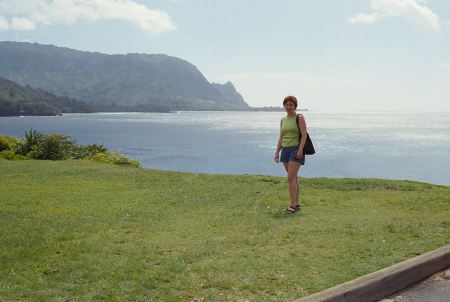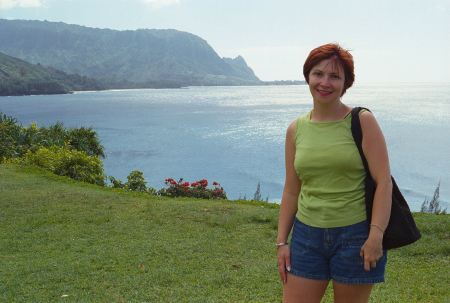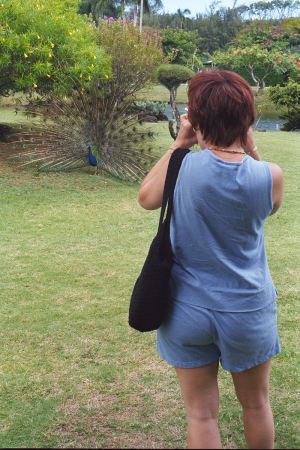We've covered a few basic principles of composition. There's a lot more: lighting, depth of field, balance, and color. The scope of this presentation is limited by time, expertise, and my intent to address a general snapshot-taking audience. If you'd like to learn more, there are lots of good books. I especially like the Kodak book, The Art of Seeing.
I'd like to wrap up with some tips on photographing people. Some snapshotters like to put people in every photo. That's fine, but it's not my style. I'd rather take two pictures: one with Cousin Nicki in front of the Eiffel Tower, and one without him. After all, film is cheap. You'd probably have to cut off the tower or Nicki or have a Nicki be so small you can't identify him.
When it is time to take a picture with people, the most important thing to remember is that all the other stuff still applies: film is cheap, get closer, explore the viewfinder, positioning is important, orientation matters, angles matter, zooming can be flattering. That's a lot to remember. Allow me to offer some more examples.
Here's a classic vacation snapshot mistake. "Kim, go stand way over there by the cliff!"

When you're taking a picture of somebody in front of something big, there's no reason to send them away. Line up your background, then add your person, but keep the person close to the camera. Here's the same beautiful coastline with a much better picture of Kim.

Notice, too, that I put Kim off-center. Remember the Rule of Thirds? And having a larger person to background ratio will improve your odds that the auto-everything camera will choose the right exposure for your person. (This shot was done manually, so any exposure problems are my own fault.)
Posing tips: Have people turn their bodies a quarter turn away from the camera, then twist their heads toward the camera. For a group, divide them in half an turn the bodies each side toward the bodies on the other. Whenever possible, remove sunglasses and hats if they create a shadow on the face.

I got the pose right in this group photo, but I should have insisted on losing the sunglasses and most of the hats. The fleet of new white t-shirts also confused the light meter.
Remember the little routine about moving your eye around the viewfinder to make sure you know what you're shooting? That's very important for group shots. Check each face and make sure it's completely visible. With a large group, it's tempting to use a wide angle lens. Avoid that if possible. If not, stack people in as few rows as possible. Otherwise the poor folks in the back will have tiny faces.
A clever group shot trick I've seen is to get real high and shoot down on the group. (Remember to look for the interesting angle?) If the group is looking up at you, you'll get a clear shot of every face, double chins vanish, and smiles are very natural. Try it at your next opportunity.
Here's another annoying thing about people: They move. They blink, scratch, sneeze, gesture, and, when they talk, their mouths become the most bizarre shapes when frozen in time. It's nearly impossible to tell if one of these unfortunate maneuvers happened when the shutter tripped. Your best defense is to take extra pictures and cull out the bad ones. The larger the group, the more pictures you should take. If by some fluke, you take several pictures and nobody blinks in any of them, congratulations, you have copies for everyone.
People are also impatient. As soon as they here the shutter, the pose is lost. You have to work fast and set expectations. Set up your shot while calling out instructions for the pose. When you're almost ready to shoot it, remind them that you're going to take more than one so they don't break formation. I generally shoot at least one of them a split second before they expect it ("One... Two... [click] Three!"), to get more relaxed, natural expressions. It takes practice. If you can make them laugh a little, do it and snap it just as the laughter dies.
Another way to deal with impatience is to try to avoid the posed shot and capture a candid or semi-candid. Pictures of people doing something are often more interesting.
